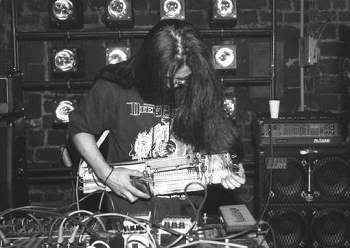

Though music is not technically considered a 'visual' art form, the same elements and design principles, used in visual art, are employed to shape and manipulate space to form waves. The sound waves that are composed initiate a reaction in ones nervous system. If one's ears were eyes, one may visualize the same surreal imagery found in 'The Elephant Celebes' by Max Ernst

"If music was sex, Merzbow would be pornography."- Masami Akita(Merzbow)
In America, pornography is often viewed as vulgar and offensive-- especially to women. Are you implying that Merzbow is for men?
"No. I mean that pornography is the unconsciousness of sex. So, Noise is the unconsciousness of music."- Masami Akita(Merzbow)
by Chad Hensley
Merzbow was born in Tokyo in 1981, the bastard son of Masami Akita. Inspired by Dadaism and Surrealism, Akita took the name for his project from German artist Kurt Schwitters' pre-War architectural assemblage "The Cathedral of Erotic Misery" done in his "merz" style-- a confluence of the organic and the geometric. "Merzbau" referred to his houses. Just as Schwitters attacked the entrenched artistic traditions of his time with his revolutionary Avant-garde collages, so too would Akita challenge the contemporary concept of what is called music. Akita would draw further influence from the Futurist movement. Not only would he embrace the Futurists' love of technology and the machine civilization, but he would push their fondness for noise to the very boundaries of the extreme.
Working in his ZDF studio, Akita quickly gained notoriety as a purveyor of a musical genre composed solely of pure, unadulterated noise. Consequently, in 1982 Masami founded the first Noise label, Lowest Music and Arts. He would eventually coin the phrase "Noise Composition" as a description for his sound, and display his pre-
recorded Noise via live performances. These presentations have included Akita's electronics battling with traditional instruments like drums and guitar, as well as solitary shows with nothing more than the man standing before a table strewn with homemade equipment.

The full extent of Merzbow's discography is probably only known to Masami himself, but the unofficial count has now surpassed 170 releases on cassette, vinyl, and CD on a diverse array of labels worldwide. In addition to Merzbow, Akita has performed with other Noise entities including Masonna, Melt Banana, Discordance Axis, Gore Beyond Necropsy, and Cock ESP. Besides creating Noise, he's authored two books on extreme culture and is a freelance writer for Japanese pornography magazines. He has also scored Ian Kerkhof's film, Deadman 2.
Tauromachine is Merzbow's latest collection of otological incendiaries. Released by America's own Relapse, tauromachine is the sound of machinery operating on full speed in a mad scientist's laboratory. The seven digital experiments presented run an aural gamut between hypnotic pulsations to violent dissordance. Each track offers the listener a disturbing journey into the deepest extremities of Noise with such 'songs' as "soft water rhinoceros", "heads of clouds", and "wounded cycad dub".
Some people claim to thoroughly enjoy Akita's orchestrated cacophonies. Rest assured, his Merzbow project is not for the weak-willed or faint-hearted; a listener must be able to savor hissing static, grinding feedback, and almost unending distortion. Noise can be difficult to digest even for those who are appreciative of musical extremes, but it all comes off with a sinister ambiance that attracts as it repels. Given his commitment to and consummate production of Noise, the sonic artwork of Masami Akita is sure to usher in the savage sounds of the next millennium.
Quotes taken from an article published in EsoTerra #8, 1999
http://merzbow.net/
No comments:
Post a Comment